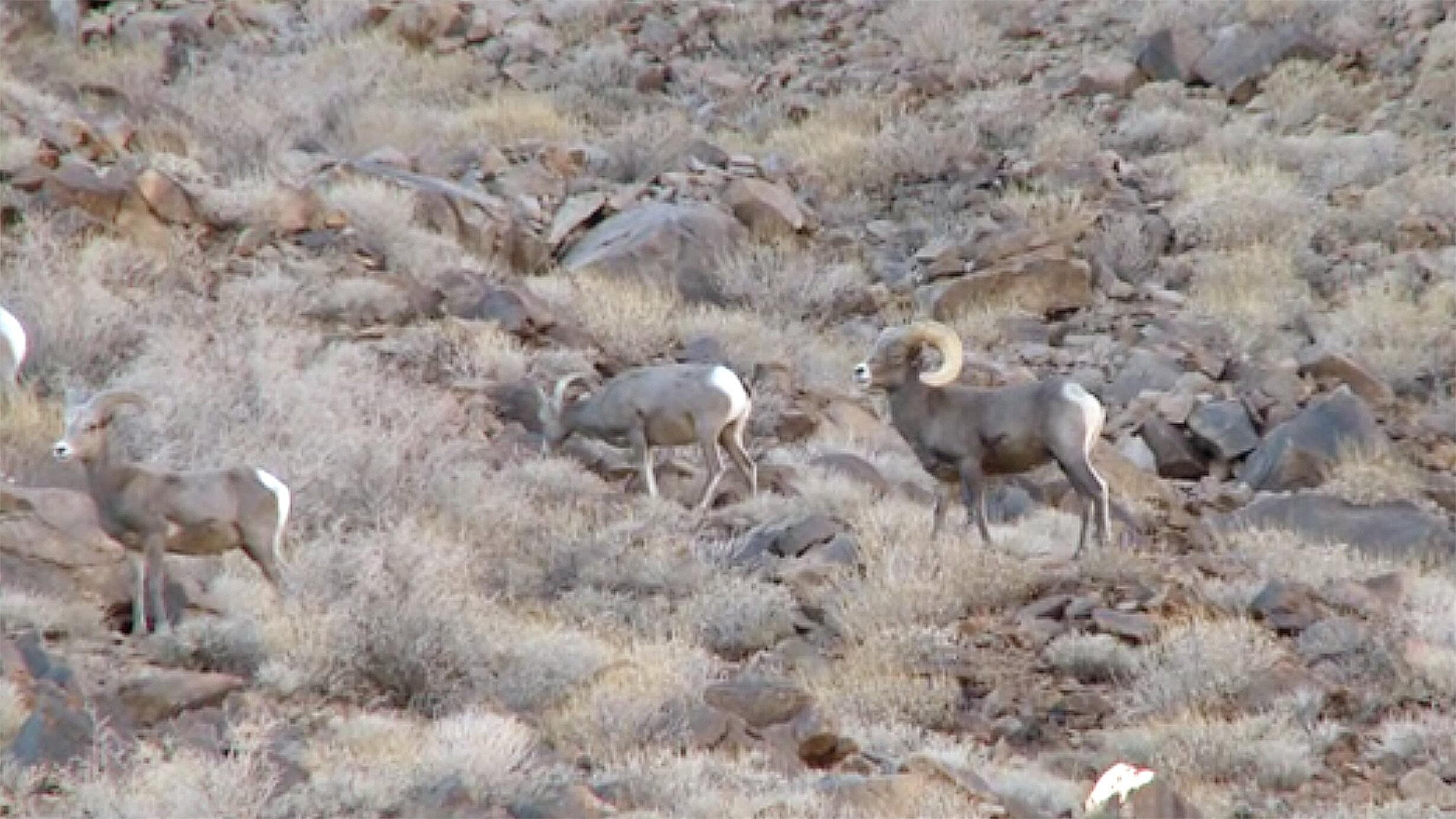Highways Block Bighorn Sheep
Part of the Ecology Disrupted Curriculum Collection.

Major highways that connect Los Angeles and Las Vegas run through bighorn sheep habitat. These highways allow travel between Los Angeles and Las Vegas in just four hours, but what do they mean for the sheep?
Students will use media, source materials, and real scientific data to investigate the question “How might being able to drive between Los Angeles and Las Vegas in just four hours put bighorn sheep at risk?”
- Essential Question: How might being able to drive between Los Angeles and Las Vegas in just four hours put bighorn sheep at risk?
- Key Topics: Habitat, Populations, Inbreeding, DNA, Measuring and Map Analysis, Genetic Diversity
- Level: 7th - 12th grade
- Pacing: Four lessons over six class periods
Key Documents
Highways Block Bighorn Sheep Teacher’s Guide PDF
Investigation Booklet PDF | Word
Lessons and Related Media
Lesson 1: Setting the Stage and the Scientific Process in Action (45 min. period)
Students learn about Dr. Clinton Epps and his research study on isolation and inbreeding in bighorn sheep. The bighorn sheep population, natural and manmade barriers, and the connection between daily life and wildlife populations are introduced.
- (Video) Highways Block Bighorn Sheep
- (Slideshow) Setting the Stage PowerPoint | PDF
- (Video) Scientist Profile: Dr. Clinton Epps
Lesson 2: Exploring: The role of isolated populations in inbreeding (45 min. period)
Students use short case studies to understand the detrimental effects of inbreeding on human and animal populations.
- (Slide Show) Inbreeding Case Study PowerPoint | PDF
Lesson 3: Investigating, Representing, and Making Meaning from Data (two 45 min. periods)
Students learn how DNA is collected in the field, use maps and rulers to analyze the genetic data collected by Dr. Clinton Epps, and then make claims based on the data. Includes an optional activity for more advanced students on understanding FST values.
- (Slideshow) Analyzing the DNA Datasets PowerPoint | PDF
- (Map) Map with Highways drawn PDF
- (Slideshow) Representing Data on a Map PowerPoint | PDF
- (Image) Map for Student Data JPG | PDF
Lesson 4: Ecology Disrupted: Changes in habitat can unexpectedly disrupt populations (two 45. min periods)
Students extend what they have learned about the unexpected consequences of human daily life on habitat and bighorn sheep populations to habitats and populations of other animal species.
- (Video) Science Bulletin: Roads Influence Animal Genes
- (Video) Science Bulletin: New Blood Gives New Life to Florida Panthers
- (Video) Science Bulletin: Loggers Imperil Monarch Butterflies
- (Video) Science Bulletin: Plastic Trash Threatens Remote Seabirds
- (Video) Science Bulletin: Species and Sprawl: A Road Runs Through It
Learning Goals and Standards
Working through the "Bighorn Sheep" unit, students will develop a deeper understanding of the following big ideas:
1. Ecological and Biological Concepts in the Context of Human Impact
- Habitat
- Habitat is the full area and physical environment where an organism lives.
- Habitat fragmentation, when an ecosystem is broken into pieces, can threaten the survival of some species.
- Populations
- A population is a group of individuals of one species living in the same area that interbreed.
- Small populations may result in inbreeding, which can often cause health problems.
- Inbreeding:
- Inbreeding is when close relatives mate and reproduce.
- Inbreeding can cause health problems or death in individuals by making it more likely for defective traits to occur.
- DNA is a tool scientists use to understand genetic exchange amongst interbreeding populations:
- Populations that interbreed (exchange genes) will be more genetically similar to one another than populations that do not breed.
- Scientists can study the similarities/differences in DNA to measure how frequently interbreeding/gene exchange occurs and whether populations are isolated from one another.
2. Human Impact in the Context of Daily Life
- The daily lives of people impact the ecology of their surroundings.
- Highways and other human activities can cause habitat fragmentation and threaten species survival.
- Highways, built to help people move around, can isolate populations from one another leading to inbred populations that are less able to survive.
3. Nature of Science
- Science is based on evidence, which take many forms and is referred to as data. Inference and conclusions are based upon data.
- Scientists are people who ask questions about the natural world and gather and interpret data to address those questions.
- Communication is central to science so that others can verify data and build upon research.
- Scientific research can help people learn about how daily life interacts with the natural world.
- Science is a human endeavor.
4. Data Representation
- Scientists use different tools to represent data.
- These tools help scientists compare and interpret data.
- Measuring distance on a map can help interpret meaning from data.
- Some representations are better than others based upon the type of data collected and the needs of analysis.
Next Generation Science Standards
Next Generation Science Standards - Middle School (Grades 6-8)
Next Generation Science Standards - High School (Grades 9-12)
Common Core Standards
Common Core - Middle School (Grades 6-8)
Common Core - High School (Grades 9-10)
Common Core - High School (Grades 11-12)
References
Epps, C.W. Palsbøll, P.J., Wehausen, J.D, Roderick, G.K., Ramey, R.R., and McCullough, D.R. 2005. Highways block gene flow and cause a rapid decline in genetic diversity of desert bighorn sheep. Ecology Letters 8: 1029-1038.